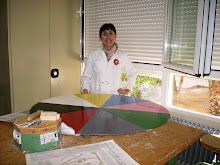 1. INTRODUCTION
1. INTRODUCTIONMatter is made up of very tiny particles called atoms. ATOMS are the smallest particles of an element that have the same chemical properties as the element itself.
Nowadays we know that the atom is not indivisible, but it is made up of smaller particles called protons, neutrons and electrons. Protons and neutrons are in the nucleus. Electrons move around the nucleus. Protons have a positive electric charge, neutrons are neutral and electrons are negatively charged. An atom has equal number of protons and electrons.
2. INSULATORS AND CONDUCTORS.
Electric charges move more easily through conductors than through insulators.
A material in which electrons can’t move easily from place to place is called an insulator (plastic, wood, glass, rubber).
Materials that are conductors contain electrons that can move more easily in the material (copper, gold, aluminium, iron).
3. VOLTAGE, CURRENT AND RESISTANCE
The flow of charge is called the current and it is the rate at which electric charges pass though a conductor. The charged particle can be either positive or negative.
In order for a charge to flow, it needs a push (a force) and it is supplied by Voltage (V), or potential difference. The charge flows from high potential energy to low potential energy. The unit is Volt (V).
The Current (I) measures the amount of charge that passes a given point every second. The unit for current is Ampere (A).
Resistance (R) is a feature of a material that determines the flow of electric charge. The unit of resistance is Ohm (Ω ). The resistance varies in different materials. For example, gold, silver, and copper have low resistance, which means that current can flow easily through these materials. Glass, plastics, and wood have very high resistance, which means that current can not pass throught these materials easily.
A German scientist Georg Simon Ohm experimented with circuits and found out the relationships between current, voltage, and resistance. It became known as Ohm's law and can be written in an equation V=IR, where V is voltage, I is current, and R is resistance.
One terminal of a cell or battery is positive, while the other is negative. It is convenient to think of current as flowing from positive to negative. This is called conventional current
A cell provides a steady voltage, so that current flow is always in the same direction. This is called direct current, or d.c. . This gives rise to alternating current, or a.c., in which the charge carriers move backwards and forwards in the circuit.
A cell provides a steady voltage, so that current flow is always in the same direction. This is called direct current, or d.c. . This gives rise to alternating current, or a.c., in which the charge carriers move backwards and forwards in the circuit.
4. OHM´S LAW
The relationship between current, voltage and resistance was discovered by Georg Ohm. He made his own wires and was able to show that the size of an electric current depended
 upon their length and thickness. The current was reduced by increasing the length of the wire, or by making it thinner. Current was increased if a shorter thicker wire was used.
upon their length and thickness. The current was reduced by increasing the length of the wire, or by making it thinner. Current was increased if a shorter thicker wire was used.


No hay comentarios:
Publicar un comentario